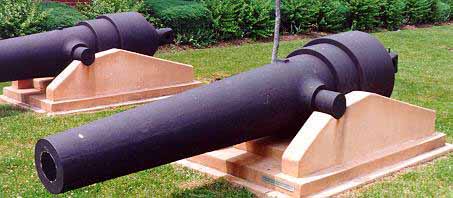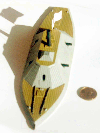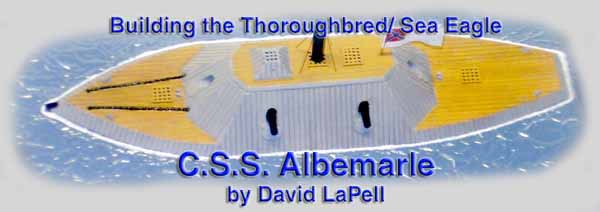I have always been fascinated by ironclad warships, especially
those of the American Civil War. Between the Union and Confederate navies,
there was such a variety of different types of ships. There were Monitors
of single, double, and even triple turrets. There were armored riverboats
that resembled medieval beasts more than ships. Then there were the sleek
Confederate rams with their angled iron sides, these floating citadels
raised havoc against the Union Navy.
 |
One of my favorite ironclads was the C.S.S. Albemarle, which was one
of the Confederate Navy’s more successful ships. The Albemarle was built
by 19 year old Gilbert Elliott in a cornfield bordering the Roanoke River
near Edwards Ferry, North Carolina. The ship was 158 feet long, had a beam
of 35 feet, and a draught of 9 feet. With her two steam engines, the Albemarle
could cruise at 5 knots. She was armed with two 6.4 inch Brooke rifled
cannons, which each could be pivoted to fire out of three different gun
ports. The Confederate ironclad was also well protected, with four inches
of wood planking that was covered by another two inches of iron. This armored
casemate that protected the ship was built at an angle of 35 degrees in
order to deflect enemy shells. |
| Completed in the spring of 1864, the Albemarle went into action immediately.
Under the command of J.S. Cooke, the Confederate ironclad was to steam
down the Roanoke River to Plymouth, and engage and drive the Union ships
downstream so that the Southern Army could take the city.
On April 19, 1864 the Albemarle engaged the Union steamers U.S.S.
Southfield and Miami, ramming and sinking the Southfield. The Captain of
the Miami was killed when a close range shot from his one of own guns deflected
off the Albemarle’s armor and exploded. The Miami then retreated. The Confederate
raider suffered no damage.
On May 5, the Albemarle and the Confederate steamer Bombshell
engaged four Union ships, the Mattabesett, Sassacus, Wyalusing, and the
Miami. Despite the Bombshell being hulled and having to surrender, the
Albemarle punctured the Sassacus’ boilers, and left the steamer with a
broken bow after Union ship attempted to ram the ironclad. The four Union
ships mounted over sixty guns against the Albemarle’s two, and even though
they fired over 500 shells, they inflicted no damage to the Confederate
ship. |
 |
 |
In October, 1864, the Union Navy came up with a plan to rid them selves
of the Albemarle. Commander William Cushing of the US Navy outfitted a
small forty five foot picket boat with a fourteen foot spar torpedo and
a 12-pound howitzer.
During the night of October 27, Cushing found the Albemarle at anchor,
surrounded by wooden logs to prevent a torpedo attack. Cushing, undaunted,
rode the picket boat over the logs, and detonated his torpedo just as a
charge of grape shot from the Albemarle blew the boat out from under him.
However the Albemarle went to the bottom, with as Cushing later described,
“a hole in her bottom big enough to drive a wagon in.” The Union Navy later
salvaged the Albemarle, and scrapped the ship post-war. |

|
| The Model
The Thoroughbred Albemarle that I built is part of their 10mm
Sea Eagle line of resin Civil War ships. I had built one of their metal
1/600 ironclads before, but I wanted something bigger. I went with the
Albemarle because of the ship’s history, and sleek look. The resin model
is a waterline hull, and is overall about eight inches long. The whole
kit is only about 15 parts, three are resin and the rest are metal. The
hull is well cast, with only a couple of pinholes that needed to be filled.
The metal 6.4 inch Brooke rifles were very nice, but I decided to drill
out the gun barrels a bit more. Since the Albemarle only had these two
guns, I mounted them to port in a broadside position. I built and painted
the guns and placed them onto the gun deck, which was painted wood, and
given a wash of black. Unfortunately, you can’t see anything inside once
the deck is in place. I then added the top deck piece on, and painted all
of the horizontal surfaces with a coat of Testors acrylic wood. For the
Albemarle’s casemate and hull sides, I used neutral gray, since no one
is sure of the color except that it was a shade of gray. Next I painted
the stack flat black and glued it in place.
|
click images
to enlarge |
 |
 |
Once the paint had dried and cured, I used a wash of thinned
Floquil steam engine black to get into the decks and the armored sides,
to bring out the detail. This also helped give the Albemarle a dingy, dirty
appearance, which was common with any ships with coal fired steam engines.
The flag was added, along with some rigging for the funnel, for which I
used large paint brush bristles glued in place. This followed with a flat
coat to help seal it all in.
For the base I used a technique I noticed in the November 2004,
Fine Scale Modeler magazine article, the details of which I will not go
into here. I spray painted somewhat wrinkled aluminum foil with a coat
of intermediate blue, then cut out a small section, and glued it to a plastic
base with Modge Podge. I then glued the model to the foil in the same way.
I coated the foil with the Modge Podge, then touched up around the base
with white paint, and sealed the whole thing with two coats of Future Floor
Wax. |
 |
 |
It only took me a couple of days to assemble and paint the Albemarle. I
think so far it was the most fun I have had with a resin ship, and it certainly
stands out next to the battleships and carriers on my shelf. If you want
to try something unique, and a little different, then I recommend highly
building an ironclad.
More
from David LaPell
|






